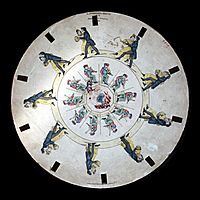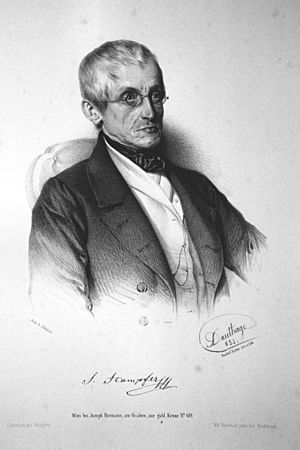Simon von Stampfer facts for kids
Simon Ritter von Stampfer (born October 26, 1792, died November 10, 1864) was an amazing Austrian mathematician, surveyor, and inventor. He was born in a place called Matrei in Osttirol, which was then part of the Archbishopric of Salzburg. His most famous invention was the stroboscopic disk. This device was one of the very first to show moving pictures! Around the same time, similar inventions were made independently in Belgium and Britain.
Contents
Simon Stampfer's Life Story
Early Years and School
Simon Stampfer was the first son of a weaver. He was born in Matrei in Osttirol. From 1801, he went to a local school. In 1804, he moved to the Franciscan Gymnasium in Lienz, where he studied until 1807. After that, he went to the Lyceum in Salzburg to study philosophy.
In 1814, Simon passed a state exam in Munich. He wanted to become a teacher there. However, he decided to stay in Salzburg. He became an assistant teacher in mathematics, natural history, physics, and Greek at the high school. Later, he moved to the Lyceum. There, he taught basic mathematics, physics, and applied mathematics. In 1819, he became a full professor. In his free time, he measured land, watched the stars, and experimented with how fast sound travels. He also used a barometer to take measurements. Stampfer often visited the Benedictine Monastery of Kremsmünster. This monastery had many cool astronomy tools he could use.
In 1822, Simon von Stampfer married Johanna Wagner. They had a daughter, Maria Aloysia Johanna, in 1824. Their son, Anton Josef Simon, was born in 1825.
First Scientific Work
After trying several times, Stampfer finally became a full professor of pure mathematics in Salzburg. But he also got a job at the Polytechnic Institute in Vienna. He became the head of Practical Geometry there. He moved to Vienna in December 1825. He taught Practical Geometry and also worked as a physicist and astronomer. He even created a way to calculate solar eclipses.
Stampfer was very interested in how accurate lenses were. He also studied how they could distort images. This led him to learn about optical illusions. In 1828, he created ways to test telescopes. He also found ways to measure the curve of lenses. He studied how glass bends and scatters light. His work helped create high-quality optical tools. He focused on a special type of lens called the achromatic Fraunhofer lens.
Inventing the Stroboscopic Discs
In 1832, Stampfer learned about experiments by a British scientist named Michael Faraday. Faraday had noticed an optical illusion. When gears spun very fast, the human eye couldn't follow their movement. Stampfer was very impressed by this. He started doing his own experiments. He used slotted cardboard wheels. He looked through the openings as the wheels spun.
From these experiments, he created his "Stroboscopic Discs" (which he also called "optical magic discs"). He even made up the word "stroboscope." It comes from two Ancient Greek words: strobos, meaning "whirlpool," and skopein, meaning "to look at." In a paper published in July 1833, Stampfer explained his invention. He said the pictures could be on a disc, a cylinder (like a Zoetrope), or a long strip of paper.
To use the disc, you would spin it. You would look through slots on one side. The pictures were on the other side. Stampfer found it easier to spin one disc with slots and pictures in front of a mirror. He also suggested covering parts of the view. This would make it look like a theater scene. The patent for his invention also mentioned clear, see-through versions. Stampfer and a printer named Mathias Trentsensky decided to sell the invention as discs to be viewed in a mirror.
Around the same time, a Belgian scientist named Joseph Plateau was working on a very similar device. He published his invention, later called the Phenakistiscope, in January 1833. Plateau said he thought he successfully put his invention together in December. He believed Stampfer started his experiments at the same time. Both Stampfer and Plateau are considered important in the history of cinema. However, Joseph Antoine Ferdinand Plateau is often given more credit.
Stampfer received a special patent for his invention on May 7, 1833. The patent said his invention could show figures and colored shapes. When these images were moved quickly in front of the eye, they created amazing optical illusions. They looked like they were moving and doing actions. These pictures were usually drawn on cardboard discs with holes around the edge. When these discs were spun quickly in front of a mirror, the lively pictures appeared to move in the mirror. This could show machines moving, carts rolling, balloons rising, and even people and animals doing different things. The patent also mentioned that more complex scenes, like theater plays, could be shown using other mechanical devices. These could use both clear and regular pictures.
The device was sold by art dealers in Vienna called Trentsensky & Vieweg. The first set of discs came out in May 1833 and sold out quickly. A second, improved version came out in July. His "stroboscopic discs" became famous outside of Austria. This is where the term "stroboscopic effect" came from.
See also
 In Spanish: Simon von Stampfer para niños
In Spanish: Simon von Stampfer para niños



